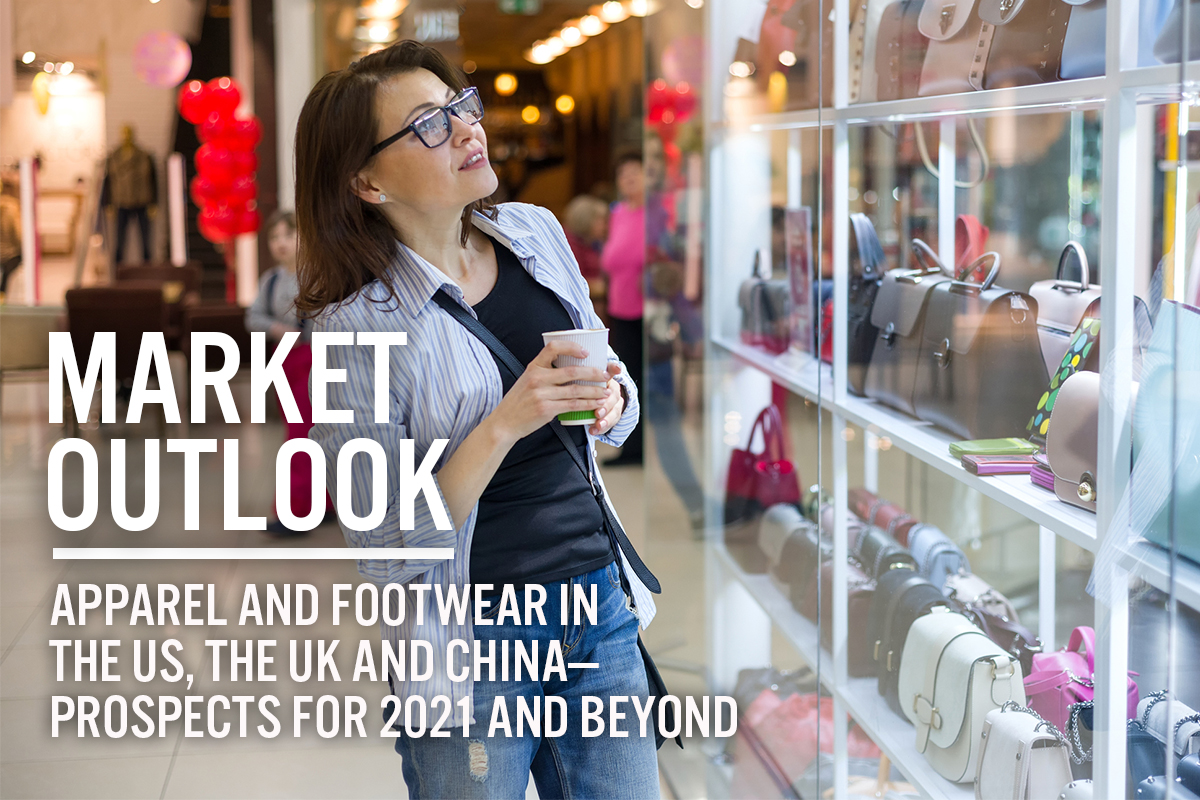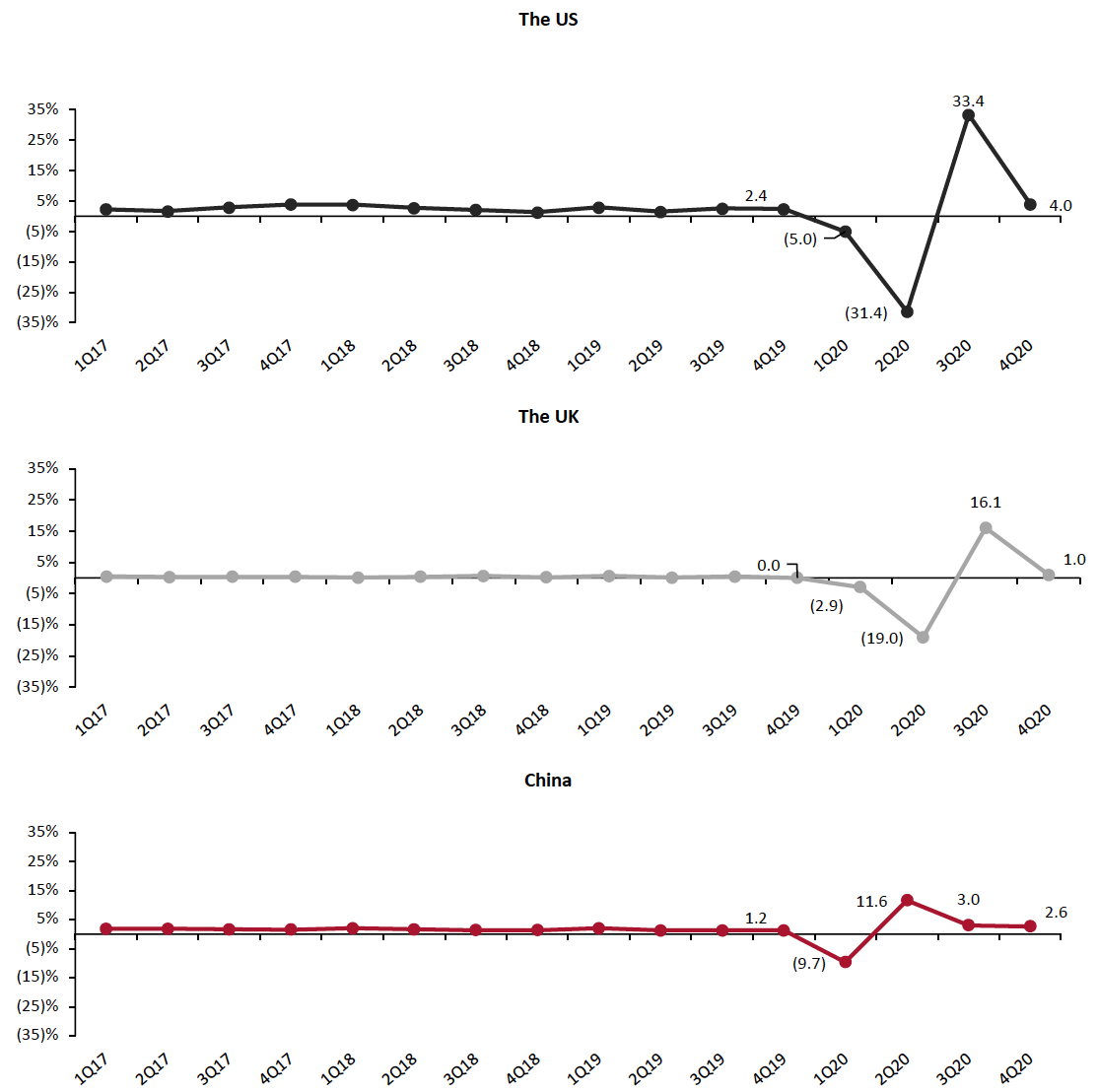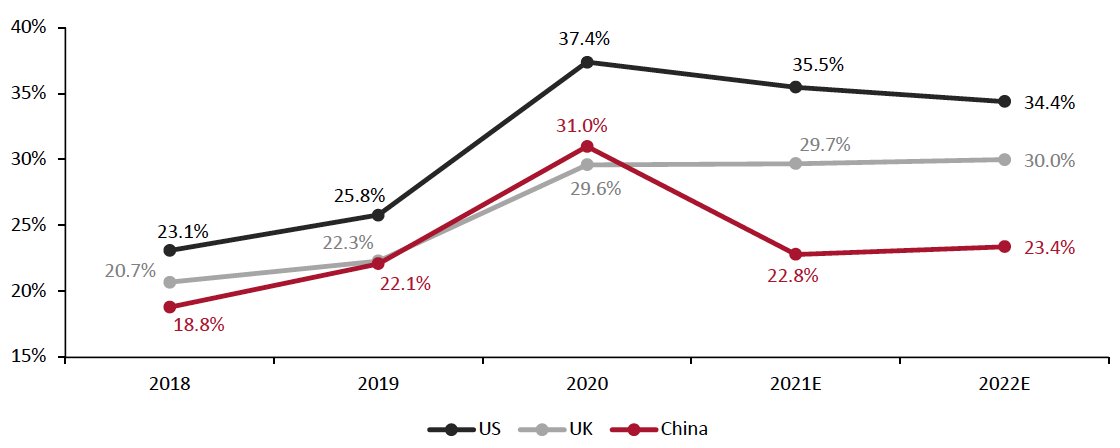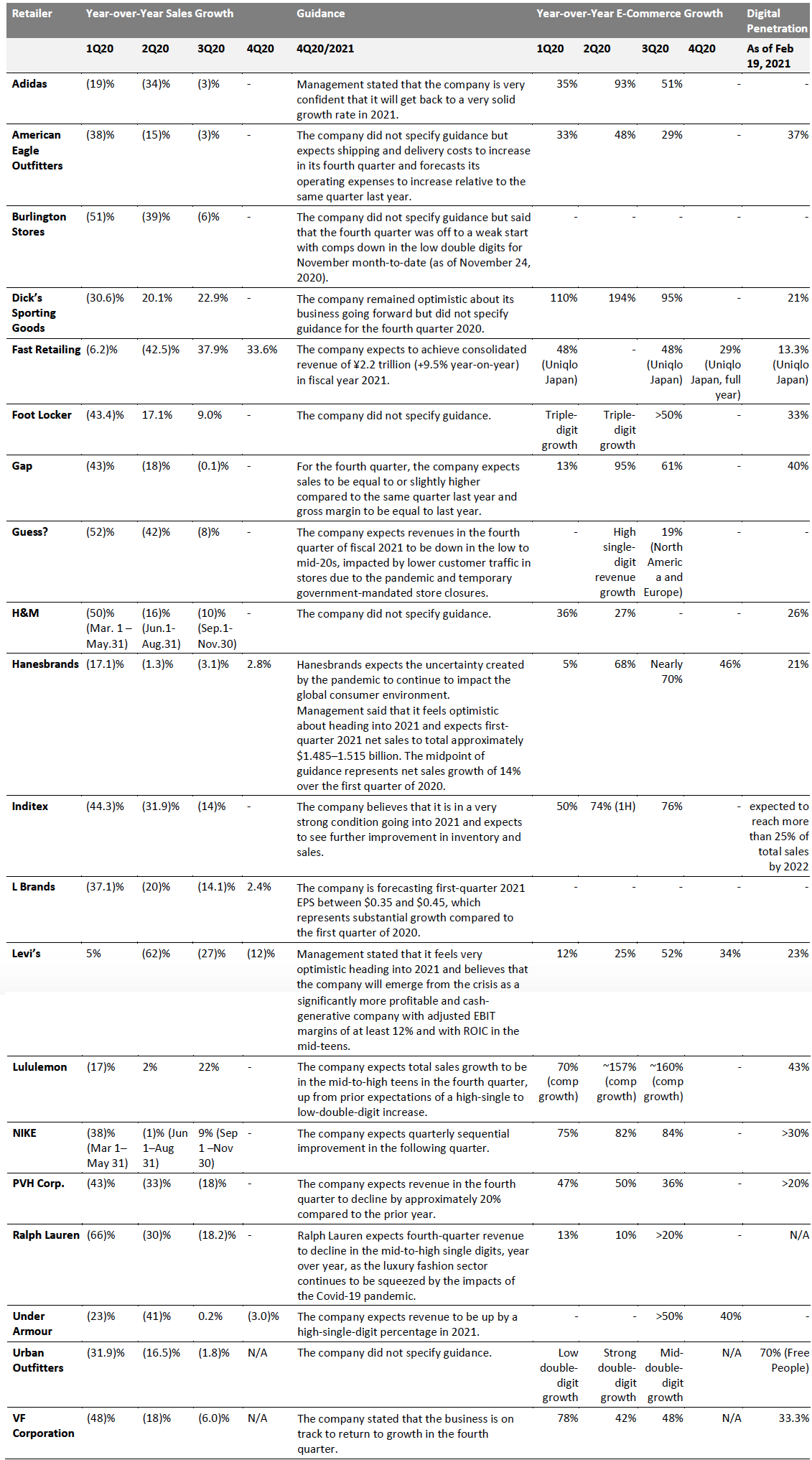
albert Chan
What’s the Story?
The pandemic has been driving changes in the global apparel and footwear industry: Consumer preferences have evolved; business models have shifted; and retailers have been improving their digital capabilities. We see 2021 as a year for trends such as casualization, sustainability and omnichannel business to reach new stages of maturity in the apparel and footwear market.
Market Performance and Outlook
Global Apparel Market Overview
The US
US consumer spending on apparel and footwear totaled $354 billion in 2020—down 12.2% year over year, according to the Bureau of Economic Analysis (BEA). This decline was primarily due to the impacts of the global Covid-19 pandemic. We estimate that the market will recover with 7.0% growth in 2021 as the health crisis moderates; growth is likely to occur predominantly in the second half of the year, when consumers may be able to return to more regular ways of living, working and spending. This outlook is based on the assumption of a sustained vaccine rollout.
We expect the market to fully recover to an approximate pre-crisis level in 2022, with estimated apparel and footwear consumer spending to total $403 billion—representing around 6.3% year-over-year growth. Once the market has recovered, we estimate that it will return to low-single-digit percentage annual growth rates, similar to those seen before the crisis.
The UK
We estimate UK consumer spending on apparel and footwear to have totaled $85 billion in 2020, down 13.9% year over year. We estimate that the UK market will grow by 8.0% year over year in 2021 (to $92 billion) and by 7.9% in 2022 (to $99 billion).
This would represent a faster recovery than we expect to see in the US apparel market, due to a deeper decline in 2020 and an earlier vaccine rollout (which we discuss in the next section).
When the UK apparel market recovers, we expect it to grow at a more stabilized rate of around 2–4% in 2023 and beyond.
China
The apparel and footwear market in China declined by 9.8% in 2020, totaling approximately $340 billion, according to Euromonitor International. We expect the market to fully recover to a pre-crisis level in 2021, seeing 11.8% growth and totaling $380 billion.
We estimate that the market will grow at a more moderate 5.5% in 2022 to reach $401 billion—only just behind the estimated value of the US market (see Figure 1). The value of China’s apparel market is likely to surpass the US apparel market by 2023.
Figure 1. US, UK and China: Apparel and Footwear Market Value (USD Bil.)
[caption id="attachment_124331" align="aligncenter" width="700"] US and UK data represent consumer spending (including sales taxes). UK 2020 spending estimated from data for the first three quarters. China data represent sales of clothing and footwear (including sales tax) as recorded by Euromonitor International.
US and UK data represent consumer spending (including sales taxes). UK 2020 spending estimated from data for the first three quarters. China data represent sales of clothing and footwear (including sales tax) as recorded by Euromonitor International.Source: Euromonitor International Limited 2021 © All rights reserved/UK Office for National Statistics/US BEA/Coresight Research[/caption]
Market Drivers
Vaccinations and Consumer’s Return to More Normal Living
While 2020 saw pandemic-led retail shutdowns, 2021 is bringing vaccine rollouts in the US, the UK and China, which offer a path out of the pandemic and hopes for market recovery.
In the US, 13.4% of the population had received at least one shot by February 24, 2021, according to the Centers for Disease Control and Prevention. We are seeing a massive boost to vaccine supplies through a pledge by vaccine makers Pfizer and Moderna to increase deliveries, as well as Johnson & Johnson gaining vaccine approval from the US government in late February. The US has also been easing Covid-19 lockdowns and has allowed stores to reopen—albeit with limited capacities and with policies varying by state.
By comparison, approximately 25% of the UK population—more than 17.5 million people—had received at least one vaccine shot as of February 24, according to the British government. On February 21, the government said that every adult in the country should receive their first vaccine shot by July 31, at least a month earlier than its previous target. The government also unveiled plans on February 23 to end lockdown restrictions by June 21 (by lifting restrictions in a phased manner from the end of March), supporting our expectation that the retail market will begin to recover in earnest in the second half of 2021.
China’s vaccination drive is falling behind the US and the UK due to consumers’ fears around vaccine safety. However, the country emerged out of the crisis faster than the US and the UK, resulting in a faster retail market recovery.
Economic Recovery
We saw GDP recover strongly in the US, the UK and China in the third and fourth quarters of 2020, and we believe that this will continue, driving increases in personal consumer expenditure and fueling the recovery of the respective apparel and footwear markets in 2021.
According to the most recent estimates from the BEA, the US economy saw 4.0% quarter-over-quarter growth in the fourth quarter of 2020 (annualized and seasonally adjusted), following an increase of 33.4% in the third quarter.
The UK economy grew at a rate of 1.0% from the preceding quarter (annualized and seasonally adjusted) in the fourth quarter of 2020, following an increase of 16.1% in the third quarter, according to the most recent data from the UK Office for National Statistics.
The high increases in third-quarter GDP in the US and the UK reflect continued economic recovery from the declines in the first two quarters of 2020, but the modest fourth-quarter growth rates indicate the ongoing impact of the pandemic, with new restrictions and closures having been implemented in selected areas in the US and the UK at the end of last year.
The China economy recovered sooner than the US and the UK, and its most severe quarter-over-quarter decline in the first quarter of 2020 was far less deep. China’s GDP growth of 11.6% in the second quarter of 2020 was followed by a 3.0% and 2.6% increase in the third and fourth quarter, respectively, according to the National Bureau of Statistics of China.
Figure 2. GDP: Change from Preceding Quarter (Annualized; %)
[caption id="attachment_124332" align="aligncenter" width="700"] Source: US BEA (top)/UK Office for National Statistics (middle)/National Bureau of Statistics of China (bottom)[/caption]
Source: US BEA (top)/UK Office for National Statistics (middle)/National Bureau of Statistics of China (bottom)[/caption]
Continued Casualization Trend
The more casual lifestyle of consumers, including in workplaces (pre-pandemic and in the future) and at home, is transforming the global apparel and footwear market. The trend has likely been further accelerated by Covid-19, as consumers have become increasingly accustomed to wearing what they like while working from home in 2020, so expectations are growing for greater comfort in apparel.
We anticipate a sustained casualization trend over the next three years, with consumers opting to wear athleisure while working more at home and workplaces increasingly relaxing dress codes. Categories such as athleisure will see greater growth in 2021 and drive the apparel market to recover. We predict that US athleisure sales will grow by 7.9% in 2021 to reach $113.5 billion, which represents almost one-third of the total apparel and footwear market in the US.
Online Market
Coresight Research estimates that the US online apparel market grew to account for 37.4% of the country’s total apparel and footwear sales in 2020, versus just over one-quarter in 2019. On the assumption that shoppers return to stores in 2021 and into 2022, albeit not at the levels seen before the crisis, we expect the penetration rate of apparel and footwear e-commerce to ease in each of those years.
The penetration rate of e-commerce in the UK apparel and footwear market will slightly increase to 29.7% and 30.0% in 2021 and 2022, respectively, according to Euromonitor, from a 29.6% share in 2020.
The China apparel online channel grew to account for 31% of total apparel and footwear sales in 2020, versus 22.1% in 2019, according to Euromonitor. The penetration rate of China apparel and footwear e-commerce will decline to 22.8% and 23.4% in 2021, according to Euromonitor; a large portion of Chinese consumers still retain the habit of shopping in-stores and are likely to return to stores for shopping after the pandemic.
Figure 3. US, UK and China: E-Commerce Share of Apparel and Footwear Sales (%)
[caption id="attachment_124333" align="aligncenter" width="700"] All UK and China e-commerce data, and US e-commerce data prior to 2020, are sourced from Euromonitor (US data for 2020 and thereafter are Coresight Research estimates). For comparability, e-commerce market sizes are represented as proportions of the total apparel and footwear market sizes recorded by Euromonitor (US market size adjusted by Coresight Research for 2020 and thereafter). For the UK and US, these base market sizes differ from the consumer spending figures cited earlier in this report, which are from different source.
All UK and China e-commerce data, and US e-commerce data prior to 2020, are sourced from Euromonitor (US data for 2020 and thereafter are Coresight Research estimates). For comparability, e-commerce market sizes are represented as proportions of the total apparel and footwear market sizes recorded by Euromonitor (US market size adjusted by Coresight Research for 2020 and thereafter). For the UK and US, these base market sizes differ from the consumer spending figures cited earlier in this report, which are from different source.Source: Euromonitor International Limited 2021 © All rights reserved/Coresight Research[/caption]
Competitive Landscape
The global apparel industry is fragmented, with the top 10 apparel brands accounting for 12.2% of global apparel sales in 2020, according to data from Euromonitor International. Even NIKE, which sells in 170 countries worldwide, holds just 3% of the global apparel market. Adidas has a 2.2% share, followed by Uniqlo (1.2%), H&M (1.2%) and Zara (1.1%).
Figure 4. Top 10 Global Apparel and Footwear Brands: Market Share, 2020 (%)
[caption id="attachment_124334" align="aligncenter" width="700"] Source: Euromonitor International Limited 2021 © All rights reserved[/caption]
Source: Euromonitor International Limited 2021 © All rights reserved[/caption]
Last year was an underperforming year for many apparel retailers. Among 20 selected apparel brands and retailers in the Coresight 100 (our focus list of the largest and most influential companies in the global retail ecosystem), 65% saw year-over-year declines in revenues in the first three quarters of 2020, impacted by the pandemic.
We expect to see different trajectories of recovery in the apparel and footwear market, by sector. For example, retailers that focus on activewear have shown signs of recovery earlier than others: Dick’s Sporting Goods, Foot Locker, Lululemon and NIKE saw negative year-over-year growth at the start of 2020 turn positive in the second or third quarter. Lululemon and NIKE both stated in their recent earnings calls that they feel optimistic about recovery in 2021.
Specialty retailers including American Eagle Outfitters, Burlington Stores, Gap and L Brands, along with other retailers and brands in the general apparel sector (such as Fast Retailing, Guess, H&M and Inditex) have also shown signs of recovery, with sequential improvement in year-over-year revenue growth in the first three quarters of 2020, but the pace is slower compared to activewear retailers.
Of the apparel companies under our coverage that reported e-commerce penetration figures, 64.2% have already achieved more than 25% digital sales penetration, according to recent earnings releases—and all companies aim to increase this penetration within the next three years to respond to consumer demand. We expect to see apparel retailers make more efforts to entice online shoppers in 2021.
Figure 5. Selected Coresight 100 Apparel and Footwear Brands and Retailers: Sales Growth, E-Commerce Growth and Digital Penetration (%)
[caption id="attachment_124335" align="aligncenter" width="700"] Source: Company reports/Coresight Research[/caption]
Source: Company reports/Coresight Research[/caption]
US Retail Innovators
We discuss three US-based innovators whose solutions can benefit the apparel and footwear market.
CreateMe
Founded in 2018 and based in New York, CreateMe is an on-demand apparel customization platform that enables apparel brands to design new products using 3D design technology and create products based on customized textiles and materials suggestions.
Leveraging 3D design technologies to develop innovative products can represent a powerful competitive advantage for apparel brands and retailers. in 2021, 3D product design will continue to evolve, allowing apparel manufacturers to visualize concepts quickly and make any number of changes before fabric is produced. Apparel retailers that have already adopted 3D design include NIKE, PVH Corp, Under Armour and Xcel Brands.
LogicSource
Founded in 2009 and based on the East Coast, LogicSource offers business sourcing and procurement services. Its OneMarket platform brings together market data and features powerful dashboards to offer critical market intelligence and benchmark information to inform retailers’ sourcing and procurement decisions. The company also sends onsite teams to work as an extension of its shared service centers to ensure that real sourcing activities are conducted in accordance with agreed pricing and policy.
In 2021, it will be increasingly important for apparel retailers to have a holistic strategy around procurement to improve the accuracy of forecasting consumer demand, reduce excess inventory and synchronize cross-functional business processes.
Revionics
Founded in 2002 and based on the West Coast, Revionics is an analytics company that offers retailers and brands lifecycle price, promotion and markdown optimization solutions. Revionics’ predictive science supports replenished merchandise and category management processes, and it can forecast markdowns that could improve profit margins.
In 2020, apparel retailers faced a highly competitive environment in which players offered attractive pricing via multiple sales channels to appeal to consumers. Pricing also reflects strategic objectives. For example, a retailer could price a new product competitively during its launch to encourage shoppers to try it, then raise prices once demand is established. In 2021, we expect retailers to formulate more effective pricing strategies through collaborating with analytics companies rather than simply offering markdowns. We expect artificial intelligence to become more important in price optimization and to be complemented by new technologies that will enhance consumer analytics capabilities for retailers.
Themes We Are Watching
From Wholesale to DTC
Impacted by the pandemic, many apparel retailers and brands—including Kontoor Brands, Levi’s and Under Armour—saw margins through wholesale channels (such as department stores and specialty stores) drop in 2020, while margins at DTC (direct-to-consumer; brand’s own websites and stores) achieved gains. Retailers are therefore adjusting their channel mix to skew more toward DTC business, and we expect this shift to continue in 2021 as more apparel brands and retailers reduce their exposure to wholesale.
- Kontoor Brands is optimizing its distribution strategy by enhancing the quality of its wholesale business through the exit of select underperforming channels, markets and points of distribution. It is also increasingly working with retailers such as Amazon, Kohl's and Walmart.
- Under Armour plans to reduce its wholesale footprint in 2021 and beyond. It expects to reduce overall North American wholesale distribution points by 2,000–3,000, to reach 10,000 doors.
- Kontoor Brands is optimizing its distribution strategy by enhancing the quality of wholesale business through the exit of select underperforming channels, markets and points of distribution and increasingly working with retailers including as Walmart, Amazon, and Kohl's.
Sustainability
In 2021, we expect apparel and footwear to continue to trend toward sustainability. A Coresight Research survey of US consumers conducted on August 26, 2020, found that a substantial 29.0% of respondents believed that the Covid-19 pandemic has made sustainability more of a factor to them when shopping. Among this group, over half said the reason is that the pandemic prompted them to reflect on what is most important; and 45.0% said that their change in attitude toward sustainability is because lockdown showed the immediate impact of changed behavior on the planet.
In 2021, consumers are likely to remain influenced by the pandemic and favor apparel brands and retailers that employ sustainable sourcing processes and other practices. According to a survey from Sourcing Journal, conducted in September 2020, 49% of brands and retailers realized that if they did not meet their sustainability commitments, they may lose business to competitors.
We are seeing the rise of sustainable apparel and footwear, led by retailers including Adidas, H&M, Kontoor Brands, Levi’s and NIKE, as well as digitally native brands such as Allbirds. We have seen recent notable examples of sustainability developments in the footwear sector:
- Denim brand Wrangler and sustainable footwear company Twisted X announced an agreement on December 11, 2020 to create a Wrangler footwear collection with a focus on sustainability.
- Adidas outlined its 2021 sustainability goals on December 28, 2020, which include producing 17 million pairs of shoes with recycled plastic waste.
- NIKE launched the NIKE Air Force 1 Low sneakers at the beginning of 2021, which feature recycled wool and synthetic leather. The company also released sustainable basketball sneakers on February 3, 2021.
- Denim brand Wrangler and sustainable footwear company Twisted X announced an agreement on December 11, 2020 to create a Wrangler footwear collection with a focus on sustainability.
Category Expansion
The global pandemic continues to impact consumers’ home and work lives, so we expect the ongoing casualization trend to drive more apparel brands and retailers to enter the casualwear space as they seek to gain market share. In 2020, apparel retailers (including Allbirds, Gap and Kohl’s) focused on expanding categories such as sportswear, athleisure, sleepwear and intimates. We expect these categories to trend in 2021, driving category sales. Athleisure is likely to be the most popular apparel category this year: We expect US athleisure sales to total $113.5 billion in 2021, comprising sports-inspired apparel and footwear ($46.0 billion) and performance apparel and footwear ($67.5 billion).
- High-end apparel brand Alice + Olivia launched its first casual collection on November 19, 2020.
- Athleta, the activewear division of Gap Inc., launched its first sleepwear collection on January 6, 2021, which includes T-shirts, camisoles, shorts, joggers, night gowns and sleep rompers.
- On December 30, 2020, Marks & Spencer announced plans to expand its womenswear activewear brand Goodmove to include kidswear and menswear, as the retailer plans to focus more on casualwear in 2021.
- Thom Browne, an American fashion brand, launched its first range of activewear on November 26, 2020.
Improvement of Agility in Supply Chain
Accumulated inventories, delayed shipping speeds and slower merchandise allocation between manufacturers and distribution centers are issues that have been mounting during the Covid-19 pandemic. As the world gradually emerges from the health crisis, we expect both US-based and global apparel brands and retailers to look for modern technologies and alternative strategies to lower inventory levels and improve the efficiency, agility and resiliency of the supply chain.
There are three primary strategies that we believe apparel brands and retailers will look to implement in 2021:
- Re-examine the sourcing mix. A number of major apparel retailers, including Abercrombie & Fitch, Fast Retailing and Lululemon, have reduced their sourcing or manufacturing exposure to China in 2019 and 2020. For US companies, import taxes will be higher in 2021, as the tariff exclusions that had shielded many businesses from former President Trump’s trade war expired on January 5. We expect to see more onshoring or nearshoring of apparel production to build a more flexible supply chain.
- Invest in modern technologies. For example, NIKE plans to scale its RFID (radio-frequency identification) capabilities across its stores in Europe, the Middle East and Africa in 2021 to enable better on-time product allocation and replenishment, and the company plans to test consumer-facing RFID capabilities such as self-checkout in Korea.
- Upgrade fulfillment model. UK retailer ASOS is upgrading its fulfillment model to enable its global warehouse network to fulfill any order from any warehouse in 2021. The new model will allow US orders to be fulfilled from the US (Atlanta), the UK or Germany, depending on where items are in stock, which will increase the inventory turnover rate, prevent delayed shipment and better meet consumer demand.
What We Think
Implications for Brands/Retailers
- The global pandemic has impacted the apparel and footwear markets in the US, the UK and China, and we expect to see different rates of recovery in 2021 and beyond. For the US, we estimate apparel and footwear sales to see 7.0% growth in 2021, weighted toward the second half of the year. We do not expect the market to fully recover to a pre-crisis level until 2022.
- The cumulative effects of the pandemic have put pressure on US apparel and footwear brands and retailers. However, we see e-commerce as a great opportunity for apparel retailers to adjust product and service offerings and drive sales. In 2021, we expect consumers to retain online shopping habits, although some spending will be redirected back to physical stores. We recommend that brands and retailers continue to offer convenient product discovery, shopping and delivery options to increase customer loyalty.
- In 2021, we believe more apparel brands and retailers will reduce their exposure to wholesale channels, with DTC business models set to become more popular.
Implications for Technology Vendors
- As the world gradually emerges from the coronavirus crisis, we expect both US-based and global apparel brands and retailers to look for modern technologies and alternative strategies to lower inventory levels and improve the efficiency, agility and resiliency of the supply chain, which presents more opportunities for innovators to partner with retailers.
Source for all Euromonitor data: Euromonitor International Limited 2021 © All rights reserved